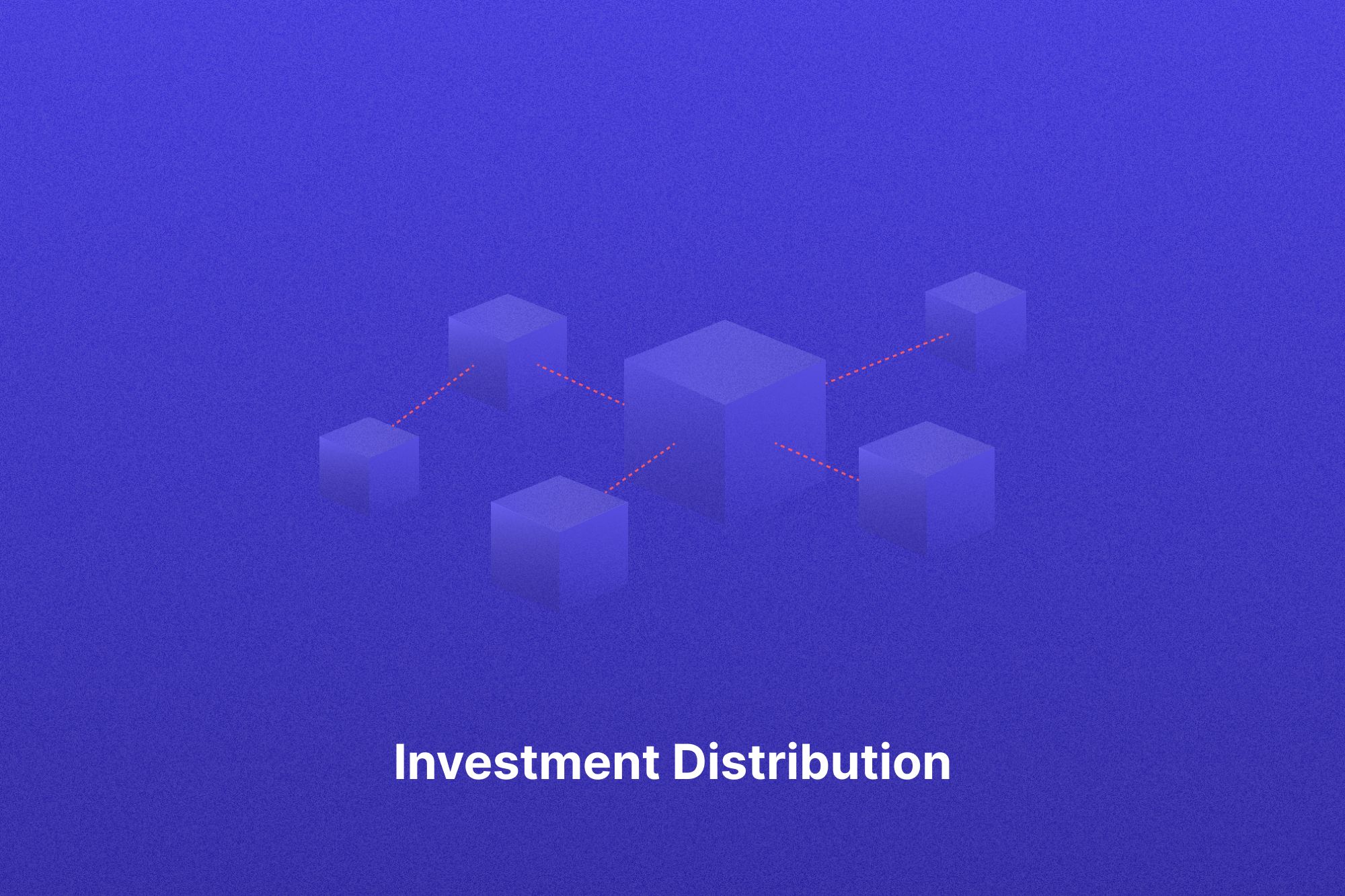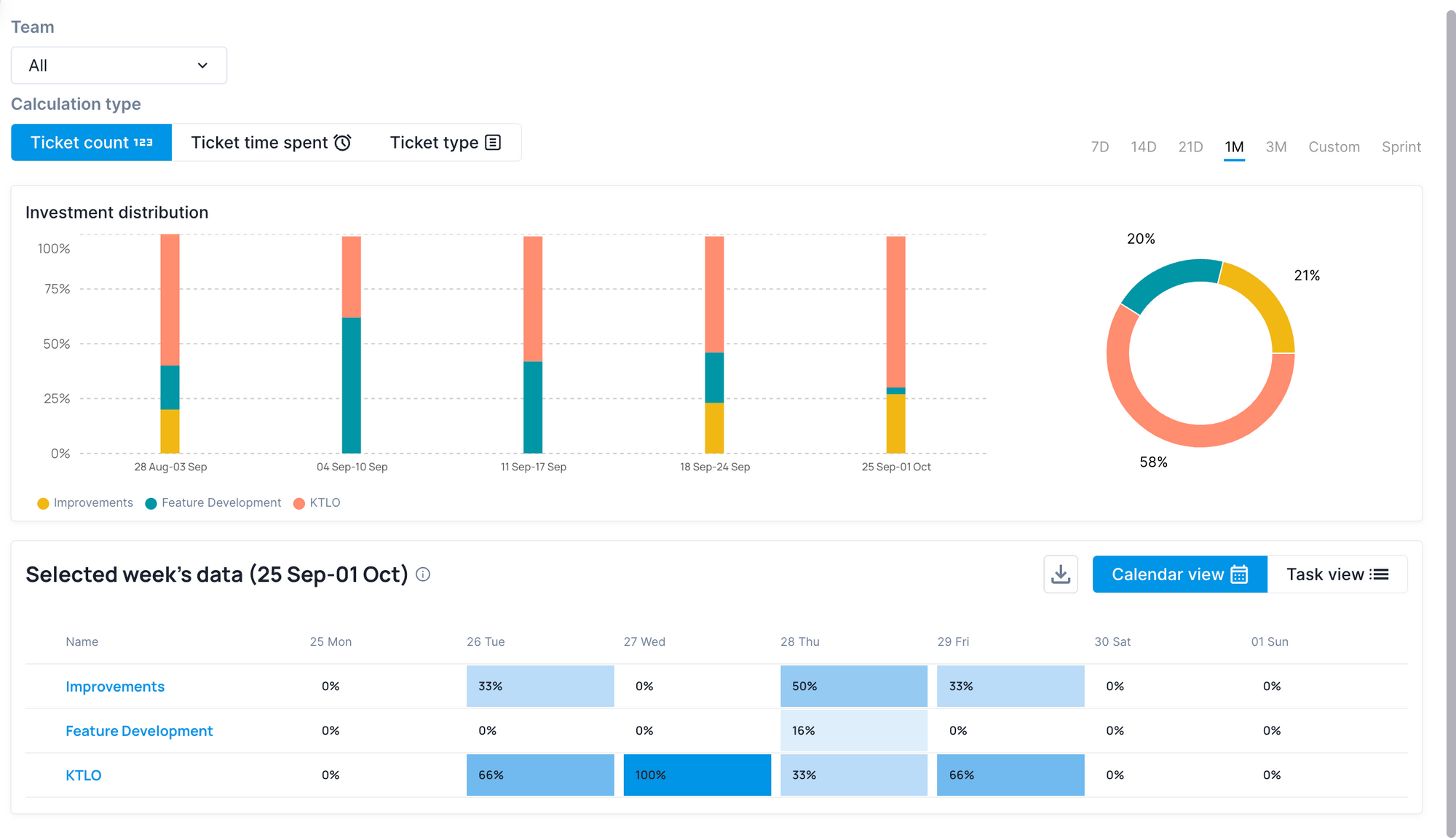Mastering investment distribution: A guide for engineering leaders

“Which projects are you working on?” is a question every engineering leader has to ask (their teams) and answer (to CTOs and CEOs). Is there a way to answer and get answers to this question without a lot of back and forth? The solution lies with engineering investment distribution!
In this article, we're going to delve into what investment distribution is and why it matters. Whether you're building groundbreaking features or keeping the lights on, understanding how to allocate your engineering resources can be the key to company success.
What is investment distribution?
Before diving deeper into mastering investment distribution, let's understand what it means. Investment distribution tells you how your engineering work is categorized — is your dev team working on new features, product updates, or simply keeping things running?
Engineering investment distribution involves distinct approaches for various types of work, such as
1. Keeping the lights on (KTLO) involves maintaining existing systems and infrastructure for business continuity. Neglecting it can lead to operational disruptions and higher long-term costs.
Let’s say your engineering team manages a complex web app. Some resources are allocated to KTLO tasks like
- Server maintenance
- Security updates
- Bug fixes
2. New feature development focuses on allocating resources toward creating and implementing new features and strategically distributing investments to align with business objectives.
3. Projects can accumulate technical debt over time, impacting efficiency and sustainability.
For instance, If your engineering team identifies technical debt in a critical app's codebase, investment distribution ensures maintainability and adaptability by
- Allocating resources to refactor code
- Enhance performance
- Update libraries
As business leaders, why should you care about this? Simple—it’s the backbone of successful resource management for your company's success. You must ensure that
- Every hour put in by your team results in the best possible outcomes for your business.
- Your team understands the overarching investment strategy. When everyone is on the same page, making informed decisions and aligning efforts with organizational goals is easier.
And today, where competition is fierce and innovation is mandatory, measuring investment distribution is more than just a nice-to-have skill—it’s a must-have.
How is distribution measured?
Measuring real-time distribution metrics means you have instant access to up-to-the-minute information about your team’s activities and resource allocation.
Imagine effortlessly analyzing data from your existing tools, like GitHub and Jira, without disrupting your team’s workflow. An automated platform seamlessly gathers, cleans, and links data from various sources, allowing you to estimate your team’s engineering efforts accurately.
For instance, it can identify the precise work put into a type of work by combining GitHub activity with Jira workflow data.
Here is a step-by-step guide on how to measure investment distribution:
- Begin by identifying the key business goals and objectives that your organization aims to achieve. In this case, let's consider 'Accelerating Product Development' as a primary objective.
- Next, categorize your engineering activities into different types, such as new feature development, maintenance, and incident resolution.
- Understand and evaluate the percentage of time spent on each activity category. For instance, you can assess the percentage of time dedicated to new feature development.
- Prioritize and allocate engineering resources to activities that directly contribute to these business goals.
- Effectively communicate the progress made by the engineering team in achieving the business goals. This will foster alignment for future plans.
Tracking investment distribution manually can be time-consuming and prone to errors. Tools like DevDynamics simplify the process by offering a complete view of what your dev team is working on.

The result? You’ll get specific information on how engineering time and resources are allocated. You can align these efforts with business goals and make informed decisions to optimize resource allocation to maximize developer productivity.
Implementing the right strategies
There are some key strategies to implement effective investment distribution. They are discussed below.
- Establish clear metrics: Define clear and measurable metrics to track investment distribution. What are your key performance indicators (KPIs)? These could include time spent on product themes, key customer accounts, task type, budget adherence, and resource utilization.
- Implement dynamic measuring systems: Utilize analytics that provides real-time insights into your engineering work and product strategy. Ensure that the tools you choose align with your defined metrics and can seamlessly integrate with your existing systems.
- Regularly review and adjust: Investment distribution is not a one-and-done task. It’s an ongoing process. Continuously assess and adapt your investment strategies based on real-time data. If you notice a type of engineering work needing to catch up, allocate more resources or adjust priorities accordingly.
These strategies ensure you have the right mindset and processes to maximize your long-term investment distribution efforts.
Benefits of investment distribution
Now that you’ve implemented these strategies, let’s study the tangible benefits you can expect from it:
1. Optimizing resource allocation
One of the primary advantages of investment distribution is the ability to optimize resource allocation. Here’s a better understanding of its working:
- Strategic resource allocation: Real-time insights enable data-driven decisions for allocating resources where they matter most. When specific tasks require increased attention, you can swiftly identify and align resources with strategic priorities, ensuring the right projects receive the right resources.
- Strategic work distribution: By dynamically allocating resources in real time, you ensure tasks are distributed strategically among your team members. This approach promotes efficiency, prevents bottlenecks, and directs resources toward high-impact projects, focusing on the 'what' rather than just the 'how much.'
2. Identifying opportunities for innovation
Innovation is a crucial driver of success in engineering organizations determined by measuring engineering investments:
- Proactive adaptation: With access to real-time information, you can proactively adapt your strategies to capitalize on emerging opportunities. For example, if you notice a sudden surge in user demand for a particular feature, you can promptly innovate to meet that demand.
3. Mitigating risk
Proper risk management is essential in engineering and project management. Analyzing investment distribution helps mitigate risks in the following manner:
- Early risk identification: Real-time data allows you to identify potential risks as soon as they arise. For instance, if time spent on product themes or key customer accounts is not in line with expectations, you can spot it immediately and take corrective action.
4. Driving return on investment (ROI)
Ultimately, measuring investment distribution drives a better return on your engineering investments. Here’s how it contributes to achieving that goal:
- Better resource utilization: By accurately allocating resources based on real-time data, you ensure your team’s efforts are channeled into types of work delivering the most value. It directly impacts ROI.
Two major challenges to consider
Every effort to measure investment distribution has its challenges. Here are the top two cases you should be aware of:
- Data accuracy: Tools rely on accurate data input. If the data entered is incorrect, the insights derived from it will also be flawed. Ensuring data accuracy is crucial.
- Scaling challenges: As your business grows, so does the complexity of investment distribution. Scaling your measuring processes and tools to accommodate this growth is a continuous challenge.
It’s essential to acknowledge these challenges and address them proactively. Doing so allows you to navigate potential roadblocks while measuring a suitable engineering investment distribution.
Investment distribution best practices for engineering managers
These engineering investment distribution practices will help you make the most of your engineering efforts and promote a culture of transparency and accountability among your team members.
- Lead by example: Demonstrate your commitment to engineering investment measurement by actively using the data and insights. When your management team sees your engagement, they will likely follow suit.
- Set clear expectations: Communicate your expectations regarding the use of the tool. Explain how it fits into your product engineering organization’s overall investment distribution strategy and why it’s essential for the team’s success.
- Use data for decision-making: Business leaders from the best engineering organizations make data-driven decisions. When faced with resource allocation choices or engineering works prioritization, rely on the insights provided by the tool.
- Celebrate success: When your technical team achieves positive results due to improved engineering investments, celebrate these successes. Recognize and reward the best engineers for their contributions.
- Feedback loop: Establish a feedback loop where team members can provide input on the new features, product strategy, and effectiveness. Continuously seek ways to improve the coursing process according to your business value.
- Promote accountability: Hold team members accountable for resource distribution and management. Use the analytics tool to identify areas for improvement.
Conclusion
Mastering investment distribution is not just a skill—it’s a strategic imperative for engineering leaders. Through this blog, we've seen the essential strategies, best practices, and tools that underpin this mastery. Real-time analytics empowers you to make informed decisions, refine resource allocation for your engineering investments, and drive better outcomes for your projects and organization.
But, the true power lies in aligning your team's efforts with your business goals. DevDynamics helps you achieve this by understanding the engineering efforts spent on different activities. Our investment distribution module shows you the time spent on improvements, feature development, and KTLO.
Ready to drive engineering success?

